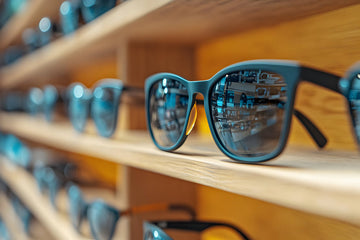Summary: Rimless and sports sunglasses are among the most trendy products in the sunglasses industry. Consumers appreciate the two styles for a variety of reasons. Both have their advantages and disadvantages that retailers should be aware of, so that they can properly advise customers.
Among the hottest types of bulk designer sunglasses right now are rimless and sports sunglasses. Both sell extremely well online, at eyewear boutiques, and even at convenience and department stores. Understanding why your customers appreciate these two types of sunglass styles could make a significant difference in your marketing efforts.
The Basics of Rimless Sunglasses
Rimless sunglasses are fairly easy to spot because they look so unusual. Their lenses are mounted directly to the bridge and temples, eliminating the need for frames all the way around. Rimless sunglasses offer the illusion of lenses floating unsupported in front of the eyes.
There are two basic designs of this particular style:
-
Three-Piece – The three-piece design calls for separate temple arms attached to the bridge component. Lenses are mounted directly to the bridge and temples.
-
Rimway – The rimway design offers a supporting arch that acts as a connection between bridge and temples. This extra arch provides additional stability for the lenses.
Both designs are considered highly stylish at a time when minimalism is appealing to so many consumers. However, rimless sunglasses require an extra bit of care. They are more fragile because the lenses aren't protected by fully surrounding frames.
Advantages of Rimless Sunglasses
It would not be surprising to learn that your customers purchase rimless sunglasses based primarily on style. But a minimalist look is only the start of what these sunglasses have to offer. Let's look at their many advantages:
-
Lightweight – Rimless sunglasses are exceptionally lightweight because of less material. Less weight means minimal pressure on the nose and at the temples. They can be more comfortable compared to other styles.
-
Vision – Because there is less frame material to get in the way, rimless sunglasses offer less obstructed peripheral vision. This is ideal for a wearer who wants to be particularly cognizant of his surroundings.
-
Comfort – Many consumers find rimless sunglasses to be quite comfortable. The style is often described as being so comfortable that a person forgets they are wearing them.
-
Versatility – While rimless sunglasses aren't exceptionally versatile from a functional standpoint, they are versatile stylistically. They work equally well in casual, professional, and leisure settings.
The Downsides
Rimless sunglasses have their downsides. At the top of the list is less durability. They are not as solid for obvious reasons. Therefore, they don't handle abuse very well. Consumers need to be careful about placing rimless sunglasses in a pocket or purse. A hardshell case is the best solution for storing them when not being used.
Another downside is less protection from the sun. Whenever you take material away from eyewear frames, there is less material to block direct sunlight and UV rays. Designers could supplement with larger or wraparound lenses, but that would only serve to defeat the purpose of investing in the rimless style.
The Basics of Sports Sunglasses
Like their rimless counterparts, sports sunglasses are a unique type of eyewear. But unlike rimless designs, they are ideal for athletic activities. They are intended for people who are physically active in outdoor sports.
Sports sunglasses tend to be designed with certain features in mind. For example, a pair intended for anglers would include polarized lenses to account for glare coming off the water. Baseball players might use a pair made with shatter-proof materials to prevent impact damage.
Lens colors can also have an impact on outdoor sports. For example, amber and dark brown lenses work well for sports like tennis and beach volleyball because they allow athletes to see with better contrast. Green is a good choice for golfers and baseball players because it both heightens contrast and preserves a good color balance.
Advantages of Sports Sunglasses
Although some consumers invest in sports sunglasses simply because they are attracted to the style, there are definite advantages to choosing them over other types of sunglasses. Athletes prefer them for the following reasons:
-
Durability – Sports sunglasses are designed with full- or semi-rim frames for maximum stability. The frames tend to be made of robust materials capable of withstanding impact damage.
-
Fit – Athletes might prefer sports sunglasses because they fit better. A good pair stays firmly on the face during exercise, even when the athlete is perspiring. A secure fit is essential in the heat of competition.
-
Functional Features – Sports sunglasses are often designed with functional features commensurate with a particular sport. For example, sunglasses for cyclists tend to offer wraparound lenses for protection against the drying wind that bothers so many athletes.
-
Enhanced Protection – Sports sunglasses also tend to feature specialized lenses offering enhanced protection. Lenses usually offer 100% UV protection along with glare reduction and impact resistance.
-
Versatility – Sports sunglasses are versatile in both function and style. A properly fitting pair with the right lenses can be used for multiple sports. Likewise, they go with more casual and leisure looks.
Sports sunglasses are closely associated with celebrity athletes. The styles currently en vogue with world-renowned athletes tend to sell best at any given time. But those trends can change quickly, so retailers really need to pay attention.
The Downsides
Sports sunglasses have their downsides to go along with the advantages. The most noticeable thing is the heavier weight. A heavier pair of sunglasses creates more pressure on the nose. And if the fit is too tight, additional pressure on the temples is not unusual.
Another potential downside is cost. Sports sunglasses can cost more than a standard pair of wayfarers or aviators, leading to unnecessary expenses for consumers who don't actually need the sunglasses to accommodate athletic activities.
Both Meet a Consumer Demand
All advantages and downsides accounted for, the bottom line for both rimless and sports sunglasses is that they meet an ongoing consumer demand. They remain trendy even as other styles seem to come and go.
Rimless and sports sunglasses can be purchased from wholesale suppliers like Olympic Eyewear. Buying wholesale offers price advantages along with the potential to save on shipping costs. Any retailer looking to stock shelves with products that consistently perform well should consider a nice selection of both styles.
FAQs
What materials are used to make rimless sunglasses?
Rimless sunglasses come with plastic lenses. The frames can be made of plastic, metal, or wood.
Are rimless sunglasses safe for everyday use?
As long as the consumer takes good care of them, rimless sunglasses can be used daily. It is not advised to wear them when conditions suggest they could be damaged.
Do all sports sunglasses offer 100% UV protection?
It would be impossible to say that they all do given that manufacturers have different policies. But as a general rule, sports sunglasses offer full protection.
How do sports sunglasses combat glare?
Sports sunglasses tend to be equipped with polarized lenses. Some also include an extra antiglare layer.
Are rimless and sports sunglasses more expensive at wholesale?
Pricing varies based on supplier. At Olympic Eyewear, rimless and sports sunglasses are competitively priced.




